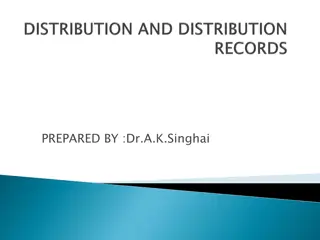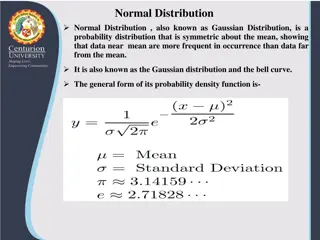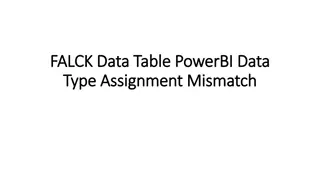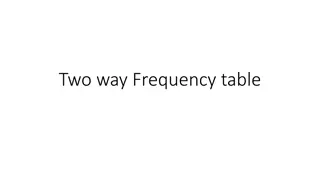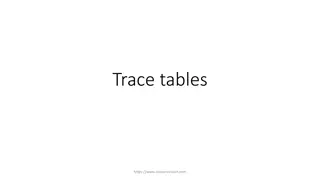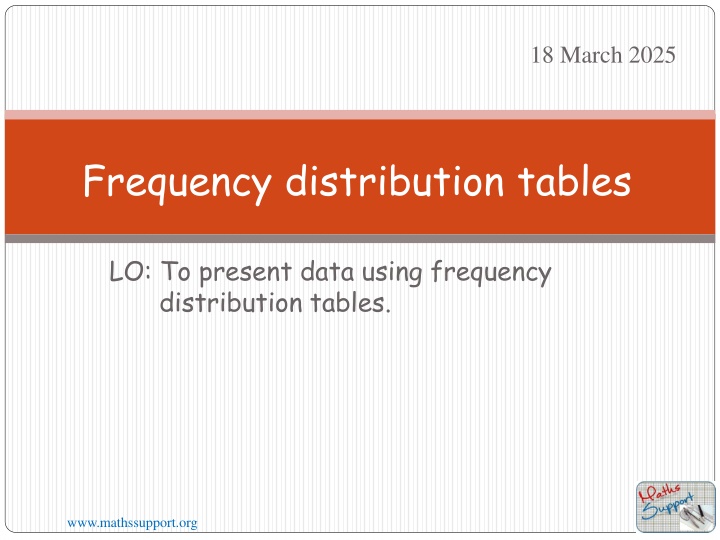
Frequency Distribution Tables for Data Presentation
Learn how to organize data into frequency distribution tables for easier interpretation. See examples of grouping quantitative discrete data and creating a grouped frequency distribution. Enhance your understanding of data organization with practical illustrations.
Download Presentation

Please find below an Image/Link to download the presentation.
The content on the website is provided AS IS for your information and personal use only. It may not be sold, licensed, or shared on other websites without obtaining consent from the author. If you encounter any issues during the download, it is possible that the publisher has removed the file from their server.
You are allowed to download the files provided on this website for personal or commercial use, subject to the condition that they are used lawfully. All files are the property of their respective owners.
The content on the website is provided AS IS for your information and personal use only. It may not be sold, licensed, or shared on other websites without obtaining consent from the author.
E N D
Presentation Transcript
18 March 2025 Frequency distribution tables LO: To present data using frequency distribution tables. www.mathssupport.org
Frequency tables When there is a large amount of data, it is easier to interpret if the data are organised in a frequency table or displayed as a graph. The number of sweets in 24 packets are shown below. 22 23 22 22 23 21 22 22 20 22 24 21 22 21 22 23 22 22 24 20 22 23 22 22 Organise this information in a frequency table. Draw a table with three columns. Number of sweets 20 21 22 23 24 2 24 TOTAL Tally Frequency Write the possible data values in the Number of sweets column. Use tally marks to record each value in the tally column. For each row, count up the tally marks and write the total in the Frequency column. Add up the values in the frequency column to work out the total frequency. 2 3 || ||| 13 4 | | | | | | ||| || | ||| || www.mathssupport.org www.mathssupport.org
Grouped Quantitative Discrete Data Ten people are asked how many times they have visited a doctor during the last 5 years. Their responses: 1, 3, 9, 5, 20, 15, 6, 7, 12, 14. [Quantitative, discrete data]. This data would be unsuitable to be tallied in a simple frequency table. WHY? www.mathssupport.org www.mathssupport.org
Grouped Quantitative Discrete Data Their responses: 1, 3, 9, 5, 20, 15, 6, 7, 12, 14, 3, 8, 7, 16, 10. The table would look like this : Visits Frequency 1 1 2 0 3 1 4 0 5 1 All of the frequencies are 1 s and 0 s, which does not give us a useful summary of the data. 6 1 7 1 8 0 9 1 10 0 11 0 12 1 13 0 14 1 15 1 16 0 17 0 18 0 19 0 20 1 www.mathssupport.org www.mathssupport.org
Grouped Frequency Distributions Their responses: 1, 3, 9, 5, 20, 15, 6, 7, 12, 14. The table would look like this : Instead, we group the data to obtain a Grouped Frequency Distribution:- Visits Frequency 1 1 2 0 3 1 4 0 Visits 0 - 4 5 9 10 14 15 19 20 - 24 Tally Frequency 5 1 6 1 7 1 8 0 9 1 10 0 11 0 12 1 13 0 14 1 15 1 16 0 17 0 18 0 19 0 20 1 www.mathssupport.org
Grouped Frequency Distributions Their responses: 1, 3, 9, 5, 20, 15, 6, 7, 12, 14. The table would look like this : Instead, we group the data to obtain a Grouped Frequency Distribution:- Visits Frequency 1 1 2 0 3 2 4 0 Visits 0 - 4 5 9 10 14 15 19 20 - 24 Tally Frequency 5 1 6 1 || |||| || | | | 7 2 | 8 1 9 1 | 10 1 | 11 0 12 1 13 0 14 1 15 1 16 1 17 0 18 0 19 0 20 1 www.mathssupport.org
Grouped Frequency Distributions Their responses: 1, 3, 9, 5, 20, 15, 6, 7, 12, 14. The table would look like this : Instead, we group the data to obtain a Grouped Frequency Distribution:- Visits Frequency 1 1 2 0 3 2 4 0 Visits 0 - 4 5 9 10 14 15 19 20 - 24 Tally Frequency 3 6 5 1 6 1 || |||| || | | | 7 2 | 8 1 9 1 | 3 2 1 10 1 | 11 0 12 1 13 0 14 1 The trick is to choose the right amount of groups to make the distribution useful. 15 1 16 1 17 0 18 0 19 0 20 1 www.mathssupport.org
Grouped Frequency Distributions Their responses: 1, 3, 9, 5, 20, 15, 6, 7, 12, 14. The table would look like this : Visits Frequency 1 1 Visits 0 - 4 5 9 10 14 15 19 20 - 24 Tally Frequency 3 6 3 2 1 2 0 || |||| || | | | 3 2 4 0 | 5 1 6 1 | 7 2 | 8 1 9 1 10 1 11 0 The trick is to choose the right amount of groups to make the distribution useful. 12 1 13 0 Depending on the number of data values, there should be between 5 and 15 groups, or classes, of equal width. The classes must cover the range of the values and they must not overlap. 14 1 15 1 16 1 17 0 18 0 19 0 20 1 www.mathssupport.org
We can construct a column graph for grouped discrete data. Visits 0 - 4 5 9 10 14 15 19 20 - 24 Tally Frequency 3 6 3 2 1 || |||| || | | | | | | May we say something about the mode? 6 5 What other conclusions may you draw? 4 frequency 3 2 1 0 25 5 10 15 20 Visits www.mathssupport.org www.mathssupport.org
Continuous data We are going to construct a grouped frequency table for continuous data. A group of teacher were asked how much time in minutes, they spent eating lunch at school 1 5 4 12 5 13 6 10 5 1 16 14 5 13 1 5 2 9 5 9 3 12 15 13 11 10 5 5 2 4 9 7 1 5 10 6 8 9 13 7 Construct a frequency table for this data with classes of 0 < t 4, 4 < t 8. Draw a table with three columns. Time (t, hours) 0 < t 4 4 < t 8 8 < t 12 Tally Frequency Write down the classes in the given form. Use tally marks to record each value in the tally column. For each row, count up the tally marks and write the total in the Frequency column. 9 | | | | | || | 14 10 7 40 || | | | | || | || | | | | | | | | | 12 < t 16 ||| TOTAL | | | Add up the values in the frequency column to work out the total frequency. www.mathssupport.org www.mathssupport.org
We can construct a histogram for grouped continuous data. Time (t) 0 < t 4 4 < t 8 8 < t 12 Tally Frequency 9 14 10 7 40 | | | | | || | || | | | | || | || | | | | | | | | | You should plot time as continuous variable on the x-axis Frequency on the y-axis 12 < t 16 ||| TOTAL | | | 14 12 Frequency histograms have equal class intervals. As continuous variable there are no gaps between bars. 10 8 frequency 6 4 2 10 5 0 15 20 Time (h) www.mathssupport.org www.mathssupport.org
Thank you for using resources from A close up of a cage Description automatically generated For more resources visit our website https://www.mathssupport.org If you have a special request, drop us an email info@mathssupport.org www.mathssupport.org







